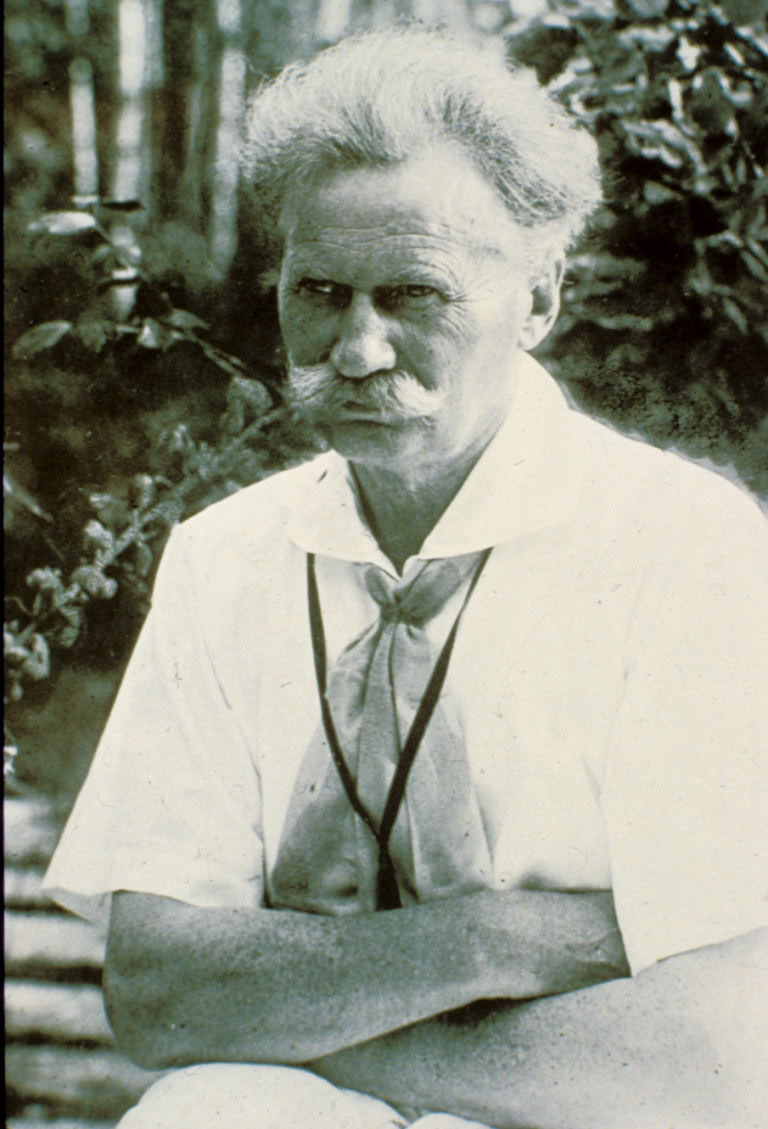Jens Jensen
Jens Jensen (1860-1951)
 Jens Jensen was born in Slesvig, Denmark, educated at Danish Folk Schools and briefly served in the German army, stationed in Berlin that introduced Jensen to gardens and boulevards designed in the fashionable French and German Renaissance styles. Jensen immigrated to the United States 1884, settling first in Florida, but soon relocated to Iowa and finally Chicago, where he was hired as a laborer for the Chicago Parks Department. Nursery work and small design projects prompted an affinity for the region’s natural dune and woodland landscapes that recalled those of Denmark. Jensen soon became enamored with the horizontality of the Midwest landscape, and his writings, design philosophy and resulting designs have cemented his place in this unique Prairie School of artists, writers, architects and landscape architects. Jensen’s Prairie School design work dominated his work as landscape architect for the Chicago Park district, culminating the creation of Columbus Park (1917-20). After leaving the Park District, Jensen opened his own design office. Private commissions were primarily in the design of extensive Chicagoland estate landscapes, including the Babson Estate (1909), Becker Estate (1926), and Rosenwald Estate ((1911-1929). Other designs included those for the Henry Ford (1914) and the Edsel and Eleanor Ford (1926-32) estates in Detroit.
Jens Jensen was born in Slesvig, Denmark, educated at Danish Folk Schools and briefly served in the German army, stationed in Berlin that introduced Jensen to gardens and boulevards designed in the fashionable French and German Renaissance styles. Jensen immigrated to the United States 1884, settling first in Florida, but soon relocated to Iowa and finally Chicago, where he was hired as a laborer for the Chicago Parks Department. Nursery work and small design projects prompted an affinity for the region’s natural dune and woodland landscapes that recalled those of Denmark. Jensen soon became enamored with the horizontality of the Midwest landscape, and his writings, design philosophy and resulting designs have cemented his place in this unique Prairie School of artists, writers, architects and landscape architects. Jensen’s Prairie School design work dominated his work as landscape architect for the Chicago Park district, culminating the creation of Columbus Park (1917-20). After leaving the Park District, Jensen opened his own design office. Private commissions were primarily in the design of extensive Chicagoland estate landscapes, including the Babson Estate (1909), Becker Estate (1926), and Rosenwald Estate ((1911-1929). Other designs included those for the Henry Ford (1914) and the Edsel and Eleanor Ford (1926-32) estates in Detroit.
Jensen’s design work for the barons of industry in Chicago and Detroit undoubtedly lead to other clients, including projects in Indianapolis for F.D. Stalnaker (Questover,1921), Goethe Link (1922), F. D. Frawley (Westerly/Golden Hill, 1922), and most notably James Allison, one of the founders of the Indianapolis Motor Speedway (Riverdale, 1911). The Riverdale landscape featured both a formal landscape adjacent to the residence, and a naturalistic landscape of planted bluff, series of small lagoons, meadow, and the reconfigured watercourse of Crooked Creek. These Jensen signature landscape features, and the Riverdale mansion are now landmark components of the campus of Marian University. Jensen’s other work in Indiana include designs for parks in East Chicago and Gary, the landscape plan for Knickerbocker Boulevard in Hammond, and residential designs in Mishawaka, Hammond, South Bend, Crown Point, Terre Haute and Crawfordsville. Jensen also designed the grounds for the Meridian Street, Indianapolis residence of United States Vice President Charles Fairbanks (1913), and as part of a collaboration with Carl Fisher in the development of the coast to coast Lincoln Highway, designed the “Ideal Section” demonstration mile in Dyer, Indiana (1923) which created a prototype landscape treatment for the then evolving automobile landscape.
In addition to being instrumental in the formation of the Cook County, Illinois Forest Preserve system, Jensens’ work with the Illinois Prairie Club and the Friends of Our Native Landscape championed preservation of the Indiana Dunes, culminating in the creation of the Indiana Dunes State Park, and subsequent Indiana Dunes National Lakeshore (now National Park).
Reference: Grese, Robert E., Jens Jensen: Maker of Natural Parks and Gardens. Johns Hopkins Press. 1992.





